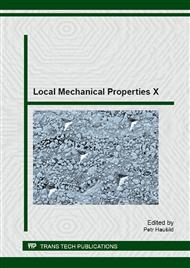p.125
p.129
p.133
p.137
p.141
p.145
p.151
p.155
p.159
Micro-CT Based Imaging and Numerical Analysis of Bone Healing
Abstract:
During distraction osteogenesis (bone lengthening) one phase is lengthening and a second phase is consolidation (fixed length, bone maturation). In this second phase of fracture healing, the callus consists of several tissue types. The response of callus bone to mechanical loading can determine the progress of treatment. The mechanical strain distribution could provide additional information of fracture healing in the same way as for bone remodeling. The architecture and tissue properties significantly affect the strength of the whole callus bone. This article focuses on imaging and numerical analysis of bone fracture healing based on input information obtained from micro-CT scans. The objective of this study is to focus on how different stiffness threshold values affect the load carrying tissue architecture and how this further influences the strain distributions within the callus. Finite element simulations are employed to investigate this. A rabbit tibia fracture callus was micro-CT scanned 30 days after osteotomy using an isotropic voxel size of 20 μm. Four computational models were created with different pixel threshold values to cover a wide range of callus tissue properties, with the purpose of finding an optimal threshold value. Optimal means here a finite element model which is computationally feasible and still contains the main load carrying tissue.The values of bone volume/total callus volume (BV/TV), bone area/total callus area (BA/TA), trabecular thickness, structure model index (SMI) were quantified to compare the differences between models. All finite element models were axially loaded to investigate the influence of threshold value on the callus reaction and influence of including the soft tissue. The BV/TV and BA/TA values indicate that for a certain threshold level, finite element models are suitable. However, a too high threshold leads to invalid finite element models. The finite element method (FEM) could be useful tool in understanding of fracture healing process.
Info:
Periodical:
Pages:
141-144
Citation:
Online since:
March 2014
Authors:
Price:
Сopyright:
© 2014 Trans Tech Publications Ltd. All Rights Reserved
Share:
Citation:


